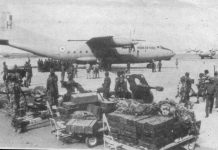ISRO (Indian Space Research Organisation) or भारतीय अंतरिक्ष अनुसंधान संगठन is India’s premier space agency assigned with the responsibility of development and maintenance of India’s space assets. Here are 50 Interesting Facts About ISRO.
1-10
1. ISRO was established in 1969, 8 years after Pakistan established Space and Upper Atmosphere Research Commission (SUPARCO) in 1961. ISRO has to this date launched 65 satellites, but SUPARCO has only been able to launch two satellites (both from foreign soil and with foreign assistance).
2. ISRO’s last 40 years expenditure is about half of NASA’s single year budget.
3. ISRO’s budget is only 0.34 per cent of the central government expenditure at present and 0.08 per cent of the Gross Domestic Product (GDP). There is so little to offer, but in turn ISRO has got more in return to offer back to the nation.
4. Dr. Vikram Sarabhai is considered the father of India’s Space Program.
5. ISRO’s Chandrayaan-1 (pictured above) cost 386 crore rupees (approx) which is almost 9 times less than what NASA spends on a similar exploration.
6. Chandrayaan-1 was India’s first unmanned lunar probe. India researched and developed its own technology in order to explore the moon. The vehicle was successfully inserted into lunar orbit on 8 November 2008. Thus, India joined an elite group of nations involved in lunar exploration which included US, erstwhile USSR, China, Japan.
7. The remote sensing lunar satellite Chandrayaan-1 had a mass of 1,380 kilograms (3,042 lb) at launch and 675 kilograms (1,488 lb) in lunar orbit. It carried high-resolution remote sensing equipment for visible, near infrared, and soft and hard X-ray frequencies. Over a two-year period, it was intended to survey the lunar surface to produce a complete map of its chemical characteristics and three-dimensional topography.
8. After suffering from several technical issues including failure of the star sensors and poor thermal shielding, Chandrayaan-1 stopped sending radio signals at 1:30 AM IST on 29 August 2009 shortly after which, the ISRO officially declared the mission over. Chandrayaan operated for 312 days as opposed to the intended two years, but the mission achieved 95 percent of its planned objectives. Among its many achievements was the discovery of the widespread presence of water molecules in lunar soil.
9. From the data collected from Chandrayaan-1 mission, ISRO scientists discovered a giant underground chamber on the moon, which could be used as a lunar base by astronauts for inter-planetary missions.
10. Chandrayaan-1 carried scientific payloads from NASA, ESA and the Bulgarian Space Agency.
11-20
11. This image became pretty famous as a metaphor as to how the high-tech Indian space program coexists with general impoverishment. The reality was quite different. Contrary to the general belief that India’s didn’t have trucks in 1980s, this is a classic example of the supposedly unique Indian concept of Jugaad. The day when the photo was taken they were taking the satellite out for an antenna-range test. With a basic understanding of physics, it is well-known that testing an antenna by placing it, in the bed of a truck isn’t the best since the truck is metallic. The simplest work-around was to use a wooden bullock cart.
12. ISRO is one of the six space agencies in the world with the capability to build and launch satellites from its own soil.
13. The heaviest satellite launched by ISRO was 5 ton. It was launched in 2001 and it is still active.
14. ISRO has till date launched 23 consecutive successful PSLV launches.
15. Apart from launching India’s 65 satellites, ISRO has also launched 29 foreign satellites till date.
16. ISRO’s headquarter is in Bengaluru, Karnataka.
17. ISRO’s first satellite, Aryabhata, was launched by the Soviet Union in 1975.
18. Rohini was the first satellite to be placed in orbit by an Indian-made launch vehicle (the Satellite Launch Vehicle 3). It was launched in 1980.
19. ISRO has 13 centers spread all across India, namely, Vikram Sarabhai Space Centre (VSSC), ISRO Satellite Centre (ISAC), Satish Dhawan Space Centre, SHAR, Liquid Propulsion Systems Centre (LPSC), Space Applications Centre (SAC), Development and Educational Communication Unit (DECU), ISRO Telemetry, Tracking and Command Network (ISTRAC), INSAT Master Control Facility (MCF), ISRO Inertial Systems Unit (IISU), National Remote Sensing Agency (NRSA), Regional Remote Sensing Service Centres (RRSSC), Physical Research Laboratory (PRL), National Mesosphere/Stratosphere Troposphere Radar Facility (NMRF).
20. Selection of candidates to work in ISRO are recruited through a ISRO Centralised Recruitment Board (ICRB).
21-30
21. The ability to supply satellite navigation signals is also the ability to deny their availability. The operator of a satellite navigation system potentially has the ability to degrade or eliminate satellite navigation services over any territory it desires. Indian defense forces are primarily dependent on American and Russian satellite navigation systems, which in times of war are liable to be shut down. The IRNSS (Indian Regional Navigational Satellite System) Navigation Satellite System planned by ISRO is a constellation of 7 satellites. The first one was launched on July 2013 and the last one is bound to be launched around 2015.
22. On July 1, 2013, India became the 6th country in the world to launch its own dedicated navigation satellite System. IRNSS 1A would provide accurate real-time positioning and timing information to users in the country, extending up to 1,500 km around the nation.
23. Current GPS receivers and mobile phones will be incompatible with the IRNSS navigation satellites.
24. GAGAN is a system designed by ISRO to receive signal from GPS (USA’s GNSS service) and refine it in a number of way to provide more accurate data for Indian subcontinent mostly for civil usage.
25. Bhuvan is a web-based 3D satellite imagery tool developed by ISRO. It is the desi form of Google Earth.
26. The INSAT series of satellites were launched by the ISRO to reduce dependence on foreign satellites and to increase local telecommunication, broadcasting and search and rescue needs.
27. The IRS series of satellites launched by ISRO were ideal for remote sensing and was expressly created for dealing with civilian use of remote sensing.
28. In September of 2012, ISRO completed its 100th space mission with the launch of two foreign satellites.
29. SAGA-220 supercomputer created by ISRO in May 2011 was the fastest supercomputer in India at the time of its launch. It is capable of performing 220 teraflops. Prithivi is currently the fastest Indian supercomputer capable of reaching a theoretical peak of 790.7 terraflops. Prithivi was designed for Indian Institute of Tropical Meteorology.
30. ISRO’s Launch facility is located at Satish Dhawan Space Centre Sriharikota High Altitude Range.
31-40
31. ISRO is all set to launch India’s Mars mission in November 2013. The project named Mangalyaan has a total budget of just $22 million to $78 million. This is an orbiter mission.
32. ISRO is planning a mission to Venus by May 2015 to study its atmosphere. The probe will reach Venus by September 2015 and would carry at least five instruments.
33. ISRO plans to carry out an unmanned mission to the sun by the year 2014. The probe is named as Aditya-1 and will weigh about 400 kg.
34. Chandrayaan-2 has been rescheduled to 2016 due to some technical difficulties. This is orbiter, lander and rover mission with a payload of about 2.6 tons. The rover will weigh 30–100 kg and will operate on solar power.
35. The Russian Space Agency is cooperating with India in developing the rover for Chandrayaan-2.
36. ISRO is also working on a Human Spaceflight Program to undertake a human spaceflight mission to carry a crew of two to Low Earth Orbit (LEO) and return them safely to a predefined destination on earth.
37. To accomplish this feat, ISRO is developing ISRO Orbital Vehicle capable of carrying three astronauts for seven days in a near earth orbit.
38. ISRO will set up an astronaut training centre in Bangalore to prepare personnel for flights on board the crewed vehicle. The center will use simulation facilities to train the selected astronauts in rescue and recovery operations and survival in zero gravity, and will undertake studies of the radiation environment of space.
39. ISRO is working on Space Capsule Recovery Experiment (SRE-II) with the main objective of realizing a fully recoverable capsule and to provide a platform to conduct microgravity experiments.
40. AVATAR is a concept under development by ISRO in collaboration with DRDO. It is a single-stage reusable spaceplane capable of horizontal takeoff and landing. This project is still in the early stages of conception.
41-50
41. Antrix is the commercial wing of ISRO, a single window agency for marketing Indian space capabilities, both products and services to the world.
42. Current DTH services providers in India rely on satellites launched by ISRO, but the progress of DTH operators has been impeded due to the nonavailability of transponders. ISRO is working on launching more transponders.
43. The scarce and extremely valuable S-Band spectrum and two satellites were contracted to a private firm, Devas, at a throwaway price of just 1000 crores by ISRO’s top brass. Mobile phone service providers have, on the other hand, been pressing for this spectrum to be set aside for extension of 3G services.
44. Indian Space Program began at Thumba Equatorial Rocket Launching Station (TERLS) located at Thumba near Thiruvanathapuram.
45. Thumba was selected because the geomagnetic equator of the earth passes over Thumba. It currently used by ISRO for launching sounding rockets.
46. SLV-3 was India’s first indigenous satellite launch vehicle. The vehicle was launched by Indian Space Research Organisation (ISRO) on July 18, 1980.
47. President A P J Abdul Kalam was the Project Director of SLV-3. The SLV-3 weighed 17 tonne and had a payload of 40 kg. The SLV-3 put 35 kg Rohini Satellite into the orbit.
48. Wing Commander Rakesh Sharma of Indian Air Force became the first Indian to fly in space in 1984 as part of a joint programme between the Indian Space Research Organisation (ISRO) and the Soviet Intercosmos space program.
49. ISRO comes under the jurisdiction of Department of Space.
50. India is a member of the United Nations Committee on the Peaceful Uses of Outer Space.



































